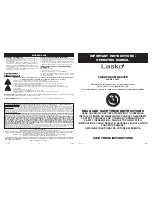
33
GI-IM048En-1013
Figure 14: Horizontal Venting -
NOTE: Drawing is meant to demonstrate system venting ONLY.
NOTES:
A. For every 1” (2.5 cm) of overhang, the exhaust vent must be located 1” (2.5 cm) vertical below overhang (overhang means top of building structure
and not two adjacent walls [corner of building]).
B. Typical installations require 12” (30 cm) minimum separation between bottom of exhaust outlet and top of air intake.
C. Maintain 12” (30 cm) minimum clearance above highest anticipated snow level or grade (whichever is greater).
D. Minimum 12” (30 cm) between vents when installing multiple vents.
E. 12” (30 cm) minimum beyond air intake.
All vent pipes must be glued, properly supported, and the exhaust must be pitched a minimum of ¼” (6.3 mm) per foot back to the
heater to allow drainage of condensate. When placing support brackets on vent piping, the first bracket must be within one (1) foot (30
cm) of the water heater and the balance at four (4) foot (1.2 m) intervals on the vent pipe. Heater venting must be readily accessible for
visual inspection for the first three (3) feet (91 cm) from the heater.
2. VENTING THROUGH AN EXISTING SYSTEM
This heater may be vented through an existing unused vent system. The inner diameter of the existing vent system is utilized for the
combustion air source. Two methods have been approved for such venting: Concentric Venting Through an Existing System and
Venting as a Chase.
Do not install the heater into a common existing vent with any other appliance. This will cause flue gas spillage or heater malfunction,
resulting in substantial property damage, severe personal injury, or death.
Содержание UGC120S-100
Страница 36: ...36 GI IM048En 1013 Figure 18 LP LP ...
Страница 39: ...39 GI IM048En 1013 D INTERNAL WIRING DIAGRAM Figure 21 Wiring Diagram LP ...
Страница 40: ...40 GI IM048En 1013 Figure 22 LP 179 L LP ...
Страница 49: ...49 GI IM048En 1013 Figure 26 LP 179 J LP ...
Страница 50: ...50 GI IM048En 1013 Figure 27 LP 179 H LP ...
Страница 52: ...52 GI IM048En 1013 MAINTENANCE NOTES ...
















































